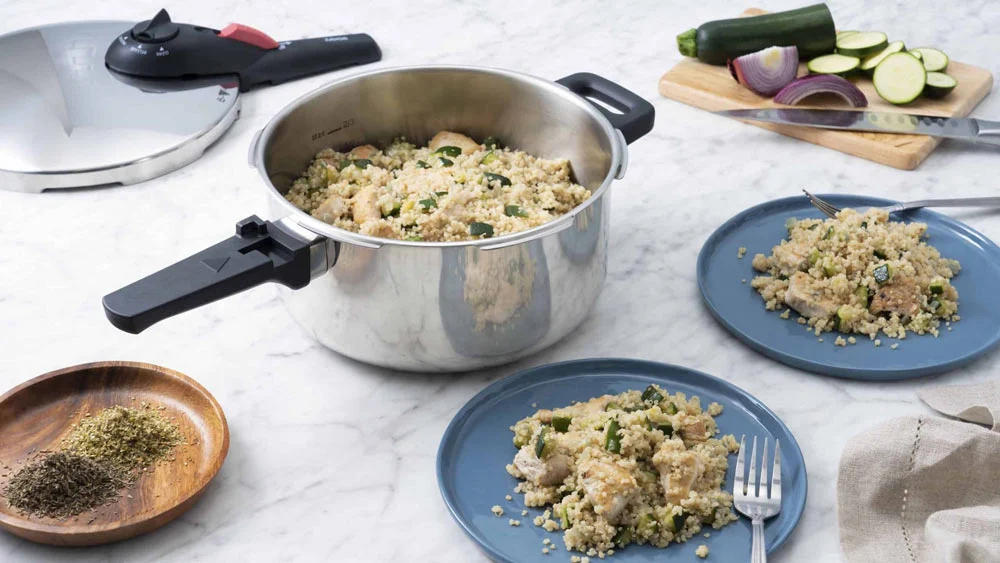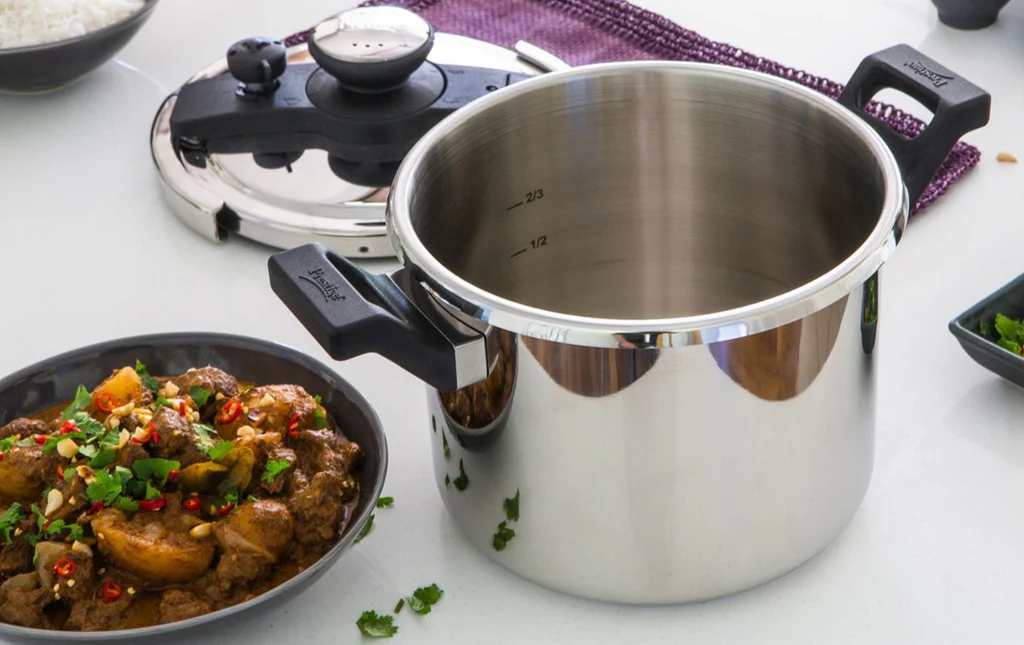There’s nothing quite like the promise of a pressure cooker. You load it up, lock the lid, and anticipate a tender, flavorful meal in a fraction of the usual time. You wait for that little pin to pop up, for the hissing to stabilize, but… nothing happens. The clock is ticking, and you’re left wondering, Why Is My Pressure Cooker Not Reaching Pressure? Trust me, you’re not alone. This is one of the most common hiccups every pressure cooker owner, including myself, faces at some point.
Don’t panic and definitely don’t give up on that pot roast just yet. The good news is that the reason is usually simple and easy to fix. We’re going to walk through the most common culprits, from the usual suspects to the less obvious ones, and get your cooker back to building pressure like a champ.
How Does a Pressure Cooker Work, Anyway?
To troubleshoot, it helps to know what’s supposed to be happening inside that pot. In a nutshell, a pressure cooker works by trapping steam. The liquid inside boils, creates steam, and because that steam can’t escape, it builds up pressure. This increased pressure raises the boiling point of the water, allowing your food to cook much, much faster.
Think of it like a superhero’s secret headquarters: for it to work, everything has to be perfectly sealed. If there’s a secret exit left open (a leak), the pressure can never build. Our job is to find that leak.
The Usual Suspects: A Troubleshooting Checklist
Let’s start with the most frequent reasons a pressure cooker fails to pressurize. Go through this list step-by-step. I’d bet that in 9 out of 10 cases, your problem is right here.
1. The Sealing Ring (Gasket) is a Mess
This is culprit number one. The silicone or rubber ring that fits inside the lid is the single most important part for creating an airtight seal.
- The Problem: The ring might be dirty, not seated correctly in its track, damaged, or just old and stretched out.
- What to Look For: Is there steam sputtering out from the edges of the lid? That’s a dead giveaway. Take the ring out. Is it greasy or have food particles stuck to it? Is it cracked, warped, or does it feel stiff instead of pliable?
- The Fix:
- Remove and Clean: Take the ring out and wash it with warm, soapy water. Clean the groove it sits in as well.
- Reseat It: Dry it completely and carefully fit it back into the track in the lid. It should sit snugly and evenly all the way around. Make sure it’s not twisted.
- Inspect for Damage: If it’s cracked or no longer fits tightly, it’s time for a replacement. They are inexpensive and essential for safety and performance. I recommend replacing it every 12-18 months with regular use.
Expert Tip from Chef Daniel Carter: “Treat your sealing ring with care. Store it separately or make sure the lid is stored upside down on the pot, not sealed shut. This prevents it from stretching and absorbing odors. A happy gasket means a happy pressure cooker.”
2. Not Enough Liquid
Your pressure cooker needs liquid (water, broth, etc.) to generate steam. No liquid, no steam. No steam, no pressure. It’s that simple.
- The Problem: You’ve underestimated the amount of liquid needed for the recipe or for your specific cooker model.
- What to Look For: You hear sizzling but no hissing, and the pot might even trigger a “burn” or “overheat” warning on an electric model.
- The Fix: Most electric pressure cookers, like the Instant Pot, require a minimum of 1 cup (250 ml) of liquid. Stovetop models often need at least 1/2 cup. Always check your user manual, as this is one of its most important guidelines. If you suspect this is the issue, use the quick release method to vent any potential steam, open the pot, and add more liquid.
3. The Lid Isn’t Locked in Place
It sounds too simple to be true, but it happens to the best of us, especially when we’re in a hurry. I remember my first time trying to make pulled pork; I was so focused on the ingredients that I didn’t turn the lid that final, satisfying click into the locked position.
- The Problem: The lid isn’t fully twisted and locked, so the mechanisms that create a seal haven’t engaged.
- What to Look For: Steam might be escaping from the sides, and the float valve (the little metal pin) will never rise.
- The Fix: Double-check that you’ve turned the lid as far as it will go until it clicks or aligns with the ‘lock’ symbol on the cooker’s base. You should hear and feel it settle into place.
4. The Pressure Release Valve is in the ‘Venting’ Position
This is the classic rookie mistake! The pressure release valve or steam release handle has two positions: ‘Sealing’ and ‘Venting’. If it’s set to ‘Venting’, all that precious steam you’re trying to build is just jetting right out the top.
- The Problem: You forgot to switch the valve to the ‘Sealing’ position before starting the cooking cycle.
- What to Look For: A steady, strong jet of steam is coming out of the valve from the very beginning.
- The Fix: Use a long-handled spoon or tongs (never your bare hand!) to carefully nudge the valve from the ‘Venting’ to the ‘Sealing’ position.
5. Something is Blocking the Seal
Even a tiny grain of rice or a bit of spice on the rim of the inner pot or the edge of the lid can be enough to break the seal and prevent your cooker from reaching pressure.
- The Problem: Food debris is preventing the lid and pot from making perfect contact.
- What to Look For: You might see steam hissing from one specific spot along the lid’s edge.
- The Fix: Cancel the cooking program and release any pressure. Open the lid and wipe the top rim of the inner pot and the corresponding sealing area on the lid with a clean, damp cloth.
Less Common (But Still Possible) Reasons
If you’ve checked all the above and are still asking why is my pressure cooker not reaching pressure, it’s time to dig a little deeper.
6. The Pot is Too Full
A pressure cooker needs headspace. That space allows the liquid to boil and create steam. If you overfill it, there’s no room for the magic to happen.
- The Problem: You’ve filled the inner pot past the maximum fill line.
- The Fix: Never fill your pressure cooker more than two-thirds full for most foods. For foods that expand, like beans, grains, and pasta, don’t fill it more than half full. This is a critical safety rule as well as a functional one.
7. Clogged Safety Valves
Your pressure cooker has several safety features, including a float valve and sometimes an emergency pressure release valve. If these are clogged with food gunk, they can’t operate properly.
- The Problem: The float valve is stuck and can’t rise to seal the lid, or another safety valve is blocked.
- The Fix: This is part of regular maintenance. After the cooker has cooled completely, remove the lid and inspect the valves. The float valve should move up and down freely. Clean it and the small silicone gasket that holds it in place. Check your manual for instructions on how to inspect and clean all safety components.
8. Your Cooker is Damaged
This is the least likely scenario, but it’s possible. A dent in the rim of the inner pot or a warped lid can make a perfect seal impossible.
- The Problem: Physical damage is preventing the parts from fitting together correctly.
- The Fix: Carefully inspect the inner pot’s rim for any dents or warping. Do the same for the lid. If you find significant damage, you will likely need to replace the damaged part. Do not try to use a visibly damaged pressure cooker.
Frequently Asked Questions (FAQ)
Q1: Why is steam escaping from the side of my pressure cooker lid?
This almost always indicates a problem with the sealing ring (gasket). It’s either dirty, not seated correctly, or old and needs to be replaced. Stop the cooking process, release pressure, and inspect the ring.
Q2: Can I still cook my food if the pressure cooker doesn’t reach full pressure?
No, you shouldn’t. The food will not cook properly or safely in the intended time. It will essentially be steaming in an unsealed pot, which defeats the purpose and can lead to undercooked, potentially unsafe food.
Q3: How often should I replace the sealing ring?
Most manufacturers recommend replacing the sealing ring every 12 to 18 months, or immediately if you notice any cracking, warping, or if it no longer fits snugly.
Q4: My electric pressure cooker is making a lot of noise but not sealing. What’s wrong?
This is a classic sign that the pressure release valve is in the ‘Venting’ position instead of ‘Sealing’. All the steam is escaping, which is why it’s loud. Carefully turn the valve to ‘Sealing’ to trap the steam.
Q5: What’s the minimum amount of liquid I need in my pressure cooker?
This varies by model, but a safe rule of thumb is at least 1 cup (250 ml) for most 6-quart electric models and 1.5 cups for 8-quart models. Stovetop models can sometimes work with less, around 1/2 to 1 cup. Always consult your user manual for the exact requirement.
The Final Word on Reaching Pressure
The pressure cooker is a game-changing kitchen appliance, but it relies on a few simple principles to work correctly. When it fails to pressurize, it’s not broken—it’s just trying to tell you that one of its key components needs a little attention. By running through this checklist, from the gasket to the liquid level, you can solve the problem quickly and safely. Once you understand these basics, you’ll rarely have to ask why is my pressure cooker not reaching pressure again, and you can get back to what matters most: making fast, delicious, and amazing meals.
